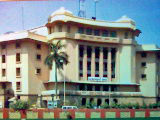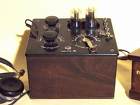

 Welcome To All India
Radio Kolkata (Un-Official Site)
Welcome To All India
Radio Kolkata (Un-Official Site)

Akashvani
Bhavan.
This building was completed in the year
1958. The same year All India Radio Kolkata(then Calcutta) shifted to this
building. The building has Rah Bhavan on the North, famous Eden Gardens on
the West & The State Assembly house on the North. There are fourteen
studios plus three FM Stereo studios. Many famous National and
International Artists have performed here. Their 'Live' and recorded
performances habe been broadcast by All India Radio Kolkata for million of
it's listeners. The studios are well equiped and are
updated regularly keeping up with the latest trends
in broadcasting round the world.
1,
Garstin Place. Illustration by Gautam Sengupta. On 26th August, 1927, the
Centre was shifted to 1, Garstin Place, with two studies. In 1940, the
number of studios increased to six. In 1958, the center was transferred to
Eden Gardens. The organization was then headed by Mr. Nripen Majumdar, Mr.
Raichand Boral, Mr. Jogesh Chandra Bose, Mr. Rajen Sen, Mr. R.C. Dey,
Mr. Pankaj Mallick, etc.
Rabindranath Tagore’s songs
were first called “Rabindra Sangeet” by Pankaj Mallick. In 1931, Smt.
Basanteswari, Banikumar joined the organization. In 1932, Raichand Boral
conducted the Bengali programme “Mahishasur Mardini” on the day of
“Shashti”, which was extremely popular.
1930, the Indian Broadcasting Co. was liquidated. The
Government of India then decided to take over. In 1935, under the Viceroy
ship of Lord Linlithglow, the Indian State Broadcasting Service became the
“All India Radio”. 2 new stations were set up at Peshwar (N.W. Frontier)
and Allahabad (U.P.), to conduct programmes for the rural audience. In
1937, a central news organization (News Service Division) was founded. In
1939, broadcasting was started for foreign audiences. In the year 1940,
Professor A.S. Bokhari became the controller of Broadcasting and became
the D.G. in 1943. In 1947, there were 6 stations in India – Calcutta,
Bombay, Madras, Delhi, Lucknow, Trivendrum; and five principle stations at
Baroda, Mysore, Trivendrum, Hyderabad & Aurangabad.
The Marconi Company from England conducted several test broadcasts
from different locations in Calcutta. The first concert program was heard
at a distance of three miles, and subsequently a discourse from the local
gulf club was heard at a distance of 72 miles. This same transmitter was
made available on loan to the Calcutta Radio Club, who launched their own
radio station in November 1923 under the callsign 2BZ. The Marconi company
made another transmitter available to the government in West Bengal who
operated their station as 5AF. Both stations in Calcutta, 2BZ and 5AF,
were closed when the national government established its own station,
7CA-VUC, in 1927.
